
Visit to National Park Bardia in 2008
07-12-2008
From Lumbini to National Park Bardia
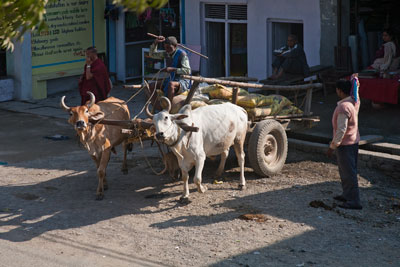
The oxes need their strength to get the cart moving.
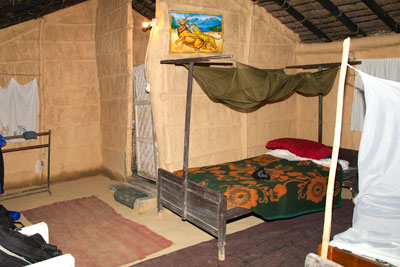
Our cottage has beds with a mosquitonet and a bathroom.
We drive to Bardia National Park. Under way a congestion because of an accident. Such a congestion can last until everything settled, including compensations. For this reason the driver chooses for a long, dusty and rough detour via by-roads.
We are still well in time at the Bardia Jungle Cottages in Tharkurdwara to visit the crocodile breeding centre, the museum and the village. There is electric light, our lodge has a bathroom, where you can get hot water for a shower and above the beds are mosquito nets hanging. Those offer however no guarantee against the nocturnal visit of mice or rats (experience of Anita).
During the diner we meet two Dutch tourists.
In the period of the maoïsts rebellion there were so few tourists that the owner of Bardia Jungle Cottages had to close the premisis. In 2008, he has just restarted and a lot of repair and maintenance work has still to be done. At the prices he counts, we got these from the two Dutch tourists, it will take a considerable period of time before he is at the former standard. You will not get aware of his low prices when you make your reservation in Kathmandu. There, one thinks apparently that the service level is the same as in Chitwan. (I assume that the extra profit stays with the Kathmandu agency).
The owner is a pleasant boss, who puts efforts in it to please his guests. One of the points he could begin with is training his kitchen staff, which I do not have seen laughing or even smiling. We had to persuade them to serve our food while it was still warm.
08-12-2008
Elephant safari and jungle walk
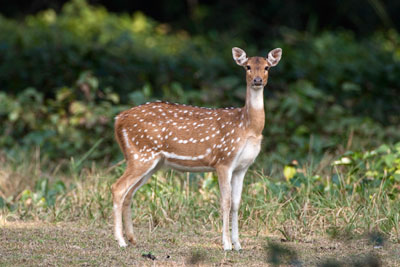
Spotted Deer
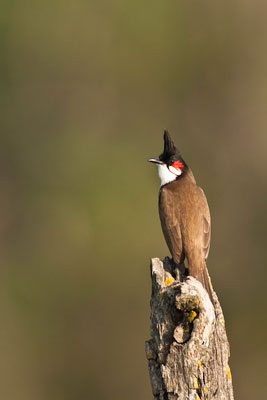
Red-whiskered Bulbul
We start the day with an elephant safari. Between half past seven and eight the rising sun shines beautiful in the misty forests.
It is a pity that the mahout hardly reacts on our requests and even if he reacts, he is very slow to put the elephant on the brakes to facilitate photographing. He is apparently eagerly searching for animals, which do not show themselves. In Chitwan an elephant safari lasts some hours, here only one hour. A quarter to nine we are on the ground again.
During the walk to the park entrance we see the half-tame rhinoceros, which we already saw yesterday on the lawn near the museum. He is eating shrubs at the border of the jungle. That is an opportunity to shoot some nice pictures.
Our guide, today and next days, is Sita Ram Chaudari, a skilled man from the village.
The jungle walk of today produces pictures of spotted deer, langur monkey, red-whiskered bulbul and some rose-ringed parakeets. The birds as from a viewing tower at the riverbank. In that tower we were sitting a long time looking out for a tiger, which is seen here quite often. However, he does not present himself to us.
09-12-2008
With a raft on the Karnalli river

Bridge over the Karnalli river in Chisapani

Landscape with Karnallli river, at our lunch place.
Today a raft on the Karnalli river. It is an excursion of almost 30 km., which lasts the whole day.
At Shakti Travels in Kathmandu, in the presence of the owner of Bardia Jungle Cottages, a canoe excursion was included in our programme and now the owner tell us that there are no canoes in Bardia, only rafts. We had already discovered that during a jungle walk you see only a few animals and the ones you do see are difficultly to approach. For this reason we did not intend to give up the excursion. The word canoe in the programme should be replaced by the word raft. We, especially Anita, make clear that we feel swindled if we do not get a raft on the river.
We were brought, in a dilapidated car, to Chisapani. At the bridge over the Karnalli river the raft was unloaded and was pumped up. The raft existed fortunately of several independent air compartments. Apparently not yet all leaks had been taped up, because some additional pumping was necessary during the tour.
It was a nice excursion, but shooting pictures of animals was not well possible. The animals we saw, were very shy. We came also not frequently close to the bank, where you normally see monkeys and all kind of birds in the shrubs and trees. The Karnalli river is very broad and frequently shallow. The channel was generally not close to the bank.
We saw one of the wild elephants that are said to be living in the park. We also saw the Gangetic dolphins or at least their back fins. I cannot show you a picture as a proof. Each time that they were seen it was at an unexpected spot.
At a picnic place, some kilometres beyond Tharkurdwara, we disembarked and were welcomed by a group school children. This time the roles had been turned and it was we that were photographed.
For the journey back to the village ox-cart was used. The ride in that cart was uncomfortable. After a try we preferred to walk.
10-12-2008
Jungle walk and Tharu dance
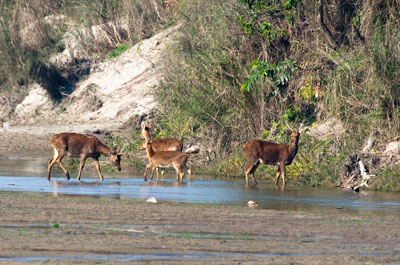
Barasingha or Swamp Deer
Jungle walk for a full day. For me, the most exiting event was seeing a group of Barasingha (Swamp Deer). I first made a series of pictures at a distance of approximately 200 meters. Afterwards we stalk closer to them. We succeeded. I could shoot nice pictures especially when they slowly moved to the other side of the river.
After the diner, a folk group performed Tharu dances for the visitors. In Chitwan the Tharu stick dance is famous, but here no sticks were used.
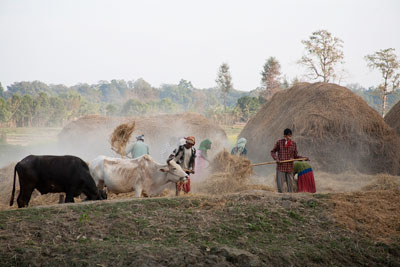
Work: threshing.
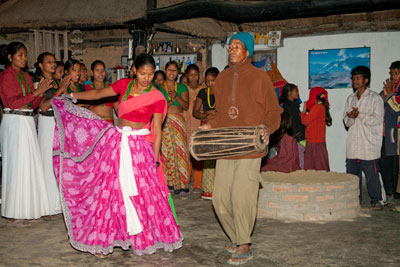 After work comes recreation: Tharu dance.
After work comes recreation: Tharu dance.11-12-2008
Drive to Narayanghat/Bharatpur
We drive, via Butwal, to Narayanghat. To the relief of our driver Arjun, we decided to split up the return drive to Kathmandu into two days. For nobody it is save that the driver turns the wheel for more than 15 hours.Ngima has made room reservations for us in the hotel of Island Jungle Resort in Bharatpur.
Bharatpur has an airport and is tied up to Narayanghat. As we agreed with Ngima to pay the hotel account ourselves Kame asks for a discount. There are, as it happens, hardly guests. That discount is given without hesitation.
Anita and I feel no need to explore the city and we stay in the hotel and the garden of the hotel.
12-12-2008
Drive to Kathmandu
During breakfast Kame tells us that yesterday evening, not far from here, a very serious bus accident happened with a bus full of school children, who returned from a picnic.In Kathmandu we go to Tibet Guest House again. We search for souvenirs. I buy two interface cards for Kame's PC, a sound card and a card with two RS232-ports.